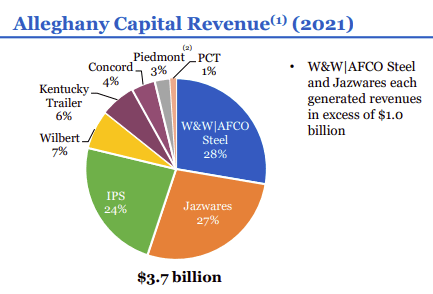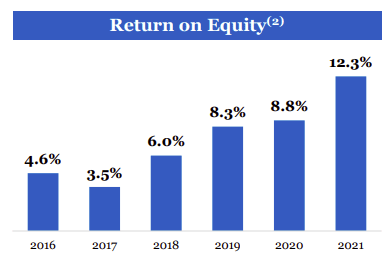Berkshire Hathaway just announced its latest acquisition plan: an offer to acquire the insurer Alleghany for $11.6B. This is an interesting purchase, as it gives us a lot to analyze about Warren Buffett’s approach to acquisitions. It can also tell us something about current market valuations and the business cycle.
Let’s take a closer look at the acquisition and what we can learn from it.
“Buy What You Know”
Insurers – and Alleghany in particular – are very familiar territory for Berkshire CEO Warren Buffett. He has run and optimized insurance businesses for decades. Notably, he acquired National Indemnity in 1966, GEICO in 1996, and General Re in 1998.
Speaking of General Re, it was led from 2001 to 2008 (under the Berkshire umbrella) by Joseph Brandon, who is also the current leader of Alleghany.
Joseph Brandon has very intentionally shaped Alleghany into what has been described as a “mini-Berkshire”. The company has used its profits to acquire a portfolio of non-insurance businesses, which was slowly turning it into a Berkshire-stye conglomerate. These companies will now be integrated into Berkshire Hathaway as well.
Alleghany’s self-description could be straight from Buffett himself:
Conservatism dominates our management philosophy. We shun investment fads and fashions in favor of acquiring relatively few interests in basic financials, industrial and other enterprises that offer the potential to deliver long-term value to our investors.
The connection to Joseph Brandon shows us how deep the understanding of Alleghany runs for Buffett. He could have bought any insurance business but picked a very familiar company with a compatible culture.
Commenting on the bid, Buffett said “Berkshire will be the perfect permanent home for Alleghany, a company that I have closely observed for 60 years“. I suspect bringing home tried-and-tested talent like 62-year-old Joseph Brandon is a nice bonus. It is even possible that Brandon could end up supervising all Berkshire insurance businesses.
The acquisition price is slightly higher than book value but still used only a small portion of Berkshire’s $146B in cash, leaving plenty for other acquisitions. In his last letter, Buffett mentioned that internal growth seems more attractive and that “little excites us in equity markets“. Alleghany has 25 days to find another better offer, but Buffett generally refuses to engage in bidding wars.
Amusingly, the rumor is that the acquisition price was $850/share, but went instead with the odd $848.02/share to remove Goldman Sachs’ fees for advising Alleghany on the topic. Buffett allegedly refused to pay the banker’s fees in the acquisition.
Alleghany the Insurer
Alleghany’s insurance business is very similar to the other insurance businesses already owned by Berkshire Hathaway. Well-run, profitable, with growing market share and book value, and a little boring.

March 2022
Alleghany has hidden potential in the same way as the other insurance businesses gathered into Berkshire Hathaway: the float.
Insurers receive money for the insurance contract first and must put that money aside to cover claims when they occur later in the future. This stash of cash, or float, can be invested to generate more returns. Alleghany’s float is worth approximately $22.8 billion.
At the moment, only 16% of this float is invested in securities for regulatory reasons, with the rest mostly in cash and bonds. The integration into Berkshire Hathaway should allow this money to be used for more productive purchases in the future.
Selling the bonds should also help Alleghany to avoid risks from rising interest rates. With Buffett’s experience with different economic cycles, we can assume he has the foresight to manage the potentially changed economic conditions and adapt to rising inflation and interest rates.

March 2022
Alleghany the Conglomerate
The part of Alleghany investing in non-insurance businesses is called Alleghany Capital and generated $3.7B in revenue in 2021. The largest investments representing 3/4 of the division revenues are:
- AFCO Steel
- Jazwares (the 7th largest toymaker in the US)
- IPS, a design and engineering firm focused on pharmaceutical and biotech plants.

March 2022
The rest of the companies owned by Alleghany are a diverse bunch as well, including hotel management, trailers, plastics parts manufacturing, precision cutting, and funeral products. This mirrors nicely Berkshire’s very diverse portfolio and investment strategy. They are also all either very niche markets or rather “boring” sectors. They also provide a good and steady Return On Equity (ROE).

March 2022
The Timing
An interesting coincidence is the previous purchases by Buffett of insurers similar to Alleghany. Berkshire purchased both National Indemnity (in 1966) and General Re (in 1998) at periods of high stock market valuation. In such an environment, Buffett struggles to find quality equities available at desirable prices. That problem is nowadays compounded by the sheer size of Berkshire Hathaway. In parallel, pressure has been mounting for Buffett to do something with the staggering amount of cash piling up in Berkshire’s coffers.
The Alleghany acquisition is probably a good way to both do something but still accumulate more dry powder for future opportunities at better prices. Alleghany Capital revenues, as well as the company’s float, will provide more capital to invest than the $11.6B costs of acquisition.
Overall, the Alleghany acquisition is neither surprising nor unusual for Buffett. The float will be utilized to finance further investment down the road, like for GEICO and General Re before. The acquisition itself is justified by a good price for a great company, high-quality management, and a lack of other cheap enough opportunities in a relatively pricey market.























